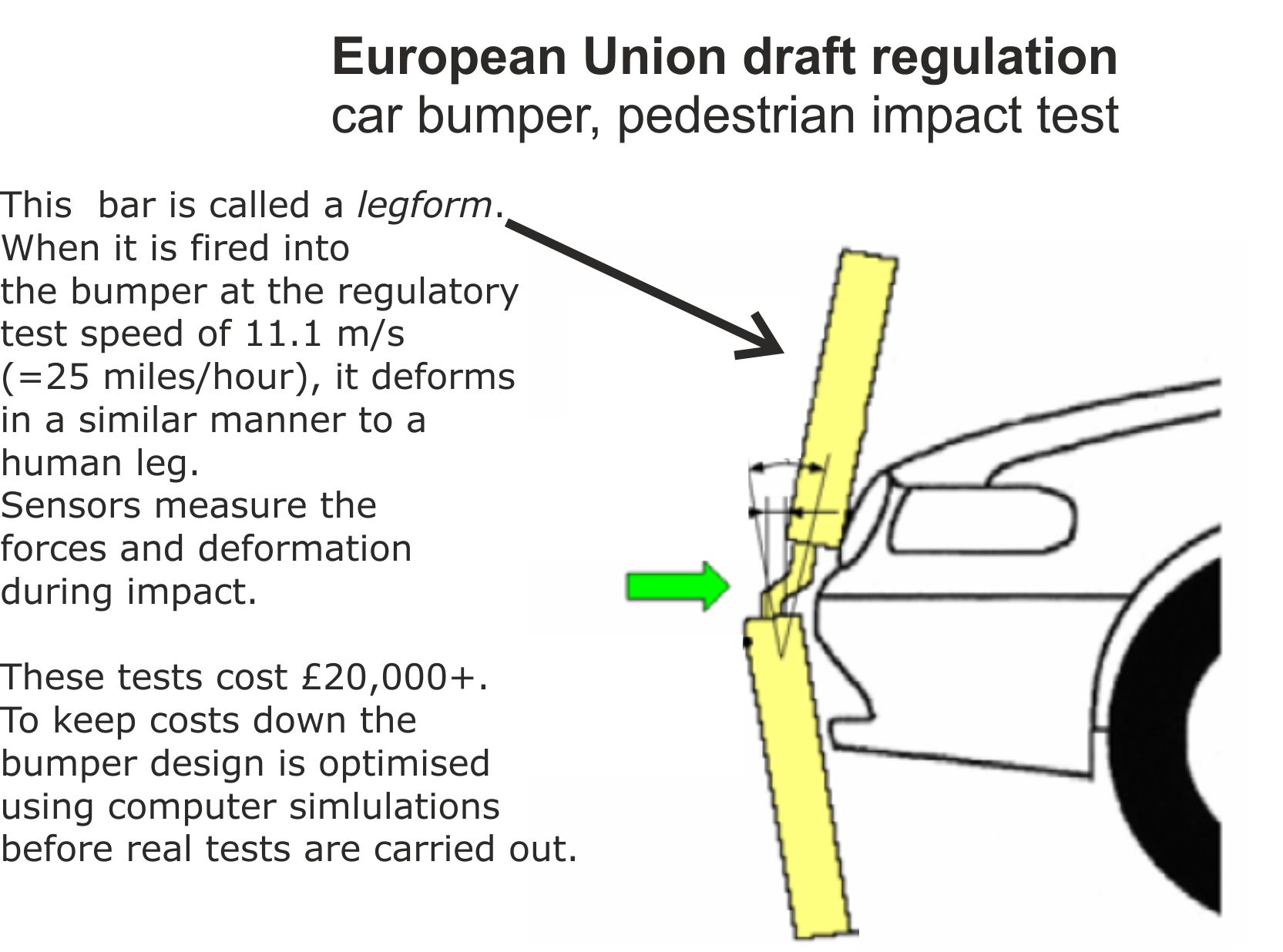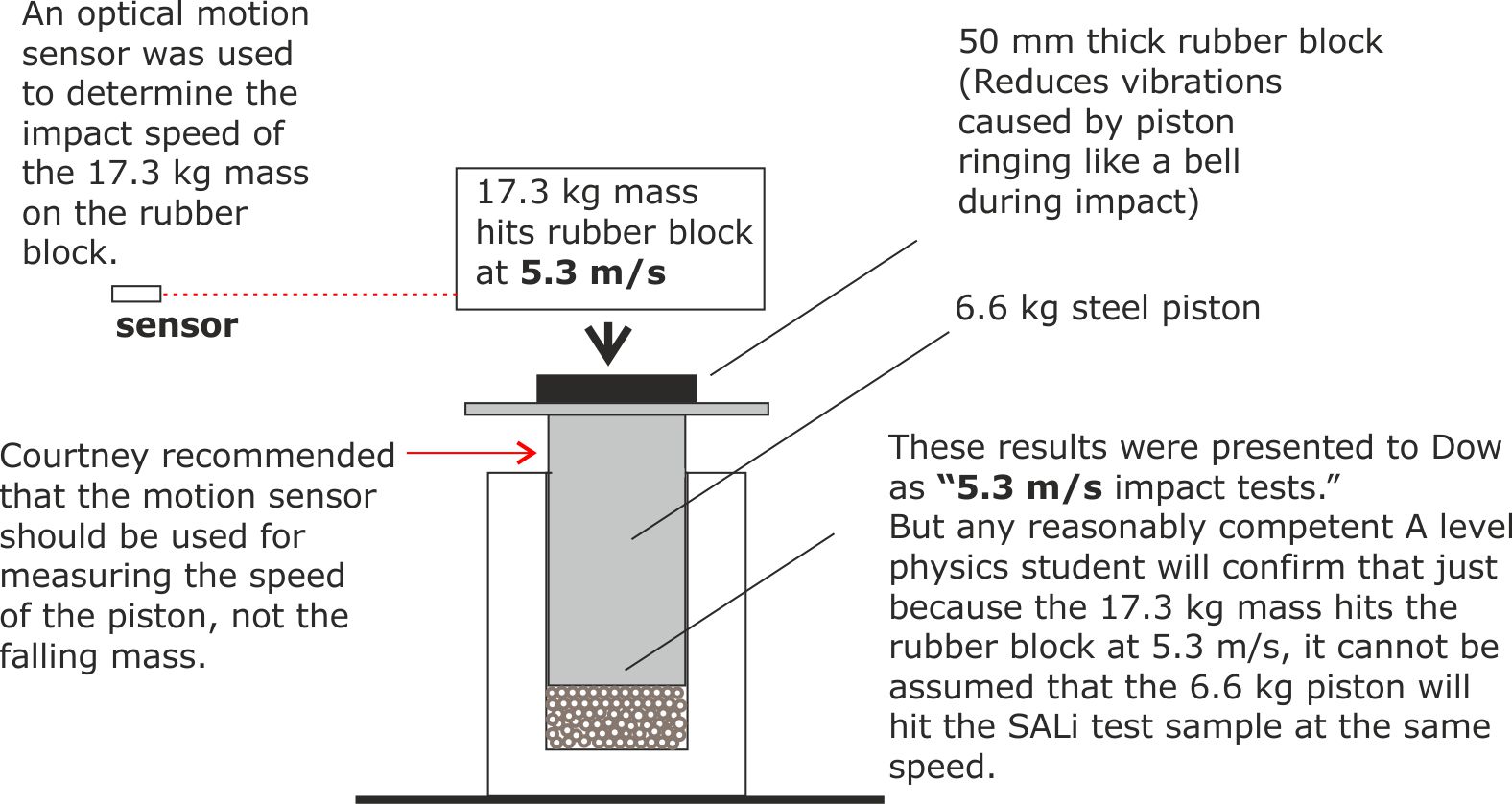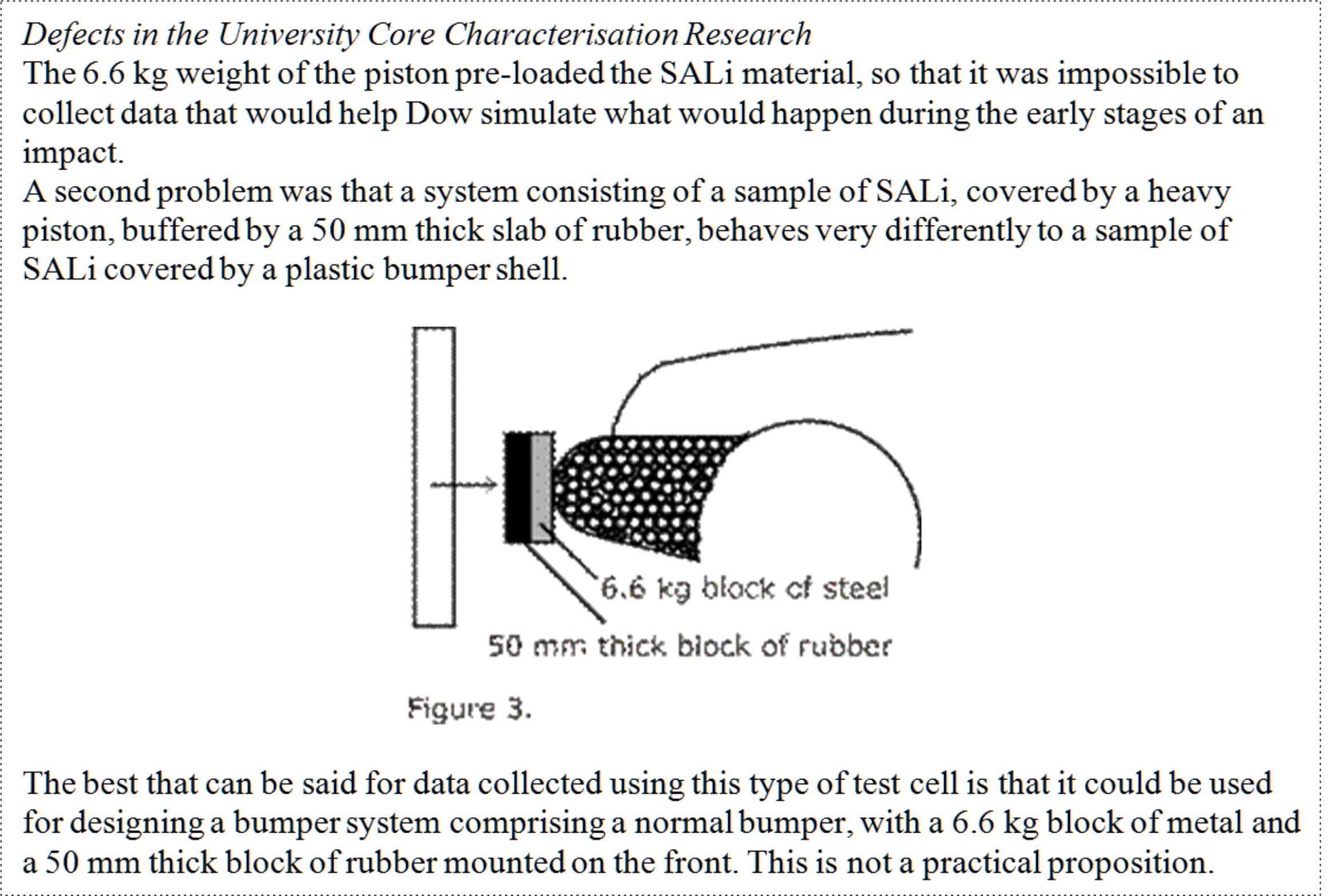A cautionary tale for British inventors
Don’t be star struck by university collaborators
Background: The PedSALi car bumper was invented in Britain. It was soft for pedestrian impacts but stiff for impacts with other vehicles. This maximised protection for pedestrians while keeping car insurance costs low.
On this page we explain how three academic engineers at Manchester University failed to accept GCE A level physics. As a consequence the PedSALi project was doomed from its early days. Pedestrian lives may have been lost as a consequence.
Q. Why did intelligent University academics goof their A Level Physics?
A. It is likely that their scientific reasoning was clouded by emotion.
At least one of the researchers was very distressed that a successful outcome to the PedSALi project would lead to fame and fortune for thePedSALi bumper inventor, Courtney.
The truth will out
For 12 years Manchester university has kept this strange lapse of competence hidden from public knowledge. But the EPSRC, one of its key funding bodies, is now calling for an "impartial and transparent" enquiry.
For some reason, known only to themselves, the University researchers 'failed to understand' four A level physics syllabus topic
(i) Newton's laws of motion.
(ii) The law of conservation of linear momentum.
(iii) The equations of motion.
(iv) The law of conservation of energy
You don't need to be an A level physics student to read this page. Ordinary common sense will probably tell you that the researchers got it wrong.
Introduction
The PedSALi project was a collaboration between the automobile division of Dow Chemicals, Cheshire Innovation and Manchester University. The aim of the project was to design and build a car bumper that was soft for pedestrian impacts, but stiff for other types of impacts such as collisions with other vehicles.
It was effectively doomed from its earliest days because the University researchers failed to carry out their core characteristics research correctly. We will briefly explain why these characteristics were important before discussing the deficiencies in the University research.

Figure 1. The agreed plan was to follow good design practice. That is, the regulatory impact tests would only be carried out by Dow at the end of the project, when the car bumper design had been optimised.

Figure 2. The computer software available to the automobile industry at the start of the PedSALi project could cope with car bumpers filled with blocks of expanded polystyrene foam. It needed to be modified to allow for the novel properties of SALi fluid.
Now we will present the evidence that the University researchers went into denial about basic physics. And that as a result, the PedSALi project failed
1 Failure to accept the law of conservation of linear momentum.
The aim of the experimental arrangement shown in Figure 1 was to obtain SALi core characteristic data. That is, data about small samples of SALi that could be plugged into computer modeling software used for simulating violent impacts.

Figure 3. The researchers assumed that because the 17.3 kg mass hit the rubber block at 5.3 m/s, the 6.6 kg piston would hit the SALi sample at 5.3 m/s.
They repeated the experiment with the 17.3 kg mass hitting the rubber block at 9.17 m/s. Again, they ignored conservation of momentum, falsely assuming that the piston would also hit the sample at 9.17 m/s.
You can check these figures and claims.
The above data is taken from
"Characterization of the Core Properties of a Shock Absorbing Composite, G. Georgiades, S.O. Oyadiji, X.Q. Zhu, J. R. Wright, and J.T. Turner, Journal of Engineering Materials and Technology, ASME, October 2007, Vol. 129, pages 497-504"
Pride comes after the fall
Pride prevented the researchers following Courtney's recommendation for checking their belief that the 6.6 kg piston moved downwards at the same speed as the 17.3 kg falling mass.
Then pride caused more trouble because Manchester was on the verge of amalgamation with its sister university, UMIST. Good UMIST engineers were alarmed by the bad physics they saw at Manchester and offered to do the core characteristic work correctly. But instead of accepting the UMIST offer, the Manchester researchers destroyed the PedSALi project by committing libel and fraud, to hide their original errors.
This led to a formal enquiry being held. But instead of exposing the truth, the enquiry panel created an implausible excuse for not examining the evidence. [We elaborate on this below.]
# The good UMIST engineers moved to another university and were not interviewed by the formal enquiry panel.
# The formal enquiry panel consisted of the heads of the Mathematics and Physics Departments at the University and a representative of the UKRIO. They would have understood clearly that the Manchester researchers had violated the laws of physics.
# In order to maintain their own professional pride, both the Manchester University Research Integrity Office and the United Kingdom Research Integrity Office (UKRIO) had to wriggle out of investigating the behaviour of the formal enquiry panel.
Update 9th July 2015
The EPSRC who paid the University £212,000 for the PedSALi research has called for the University to carry out an "impartial and transparent" enquiry into the events at Manchester University over the last 16 years. The head of the Manchester University Research Integrity Office will only be allowed to appear as a witness.
The UKRIO has agreed to cooperate with the enquiry.
2 Failure to accept Newton's laws of motion
The following issues are discussed in detail on the linked web page listed below.
2.1
In order to calculate the true impact speed of the piston on the SALi sample, a property of the rubber block called its Coefficient of Restitution (CoR) needs to be known. If the CoR has precisely the right value, then the impact speed of the piston on the sample will indeed be the same as the impact speed of the falling mass on the rubber block. ButNewton’s Laws of Motion show that this can only be true for one impact speed. So, at least one of the sets of results in the published paper has to be wrong.
2.2
Newton's Laws of Motion were also violated by the researchers because they claimed that by attaching accelerometers to the equipment and solving impressive looking simultaneous differential equations they could eliminate the physical properties of the rubber block and massive piston. - But nature cannot be cheated by "clever" maths.
This hubris that nature could be cheated was the excuse the researchers used for not measuring the speed of the piston directly.
[Thee researchers arguments supporting their arrogant belif are fairly technical. A level physics students should be able to follow them by reading Courtney's critique of the journal paper on this linked page.]
Academic pride, or other negative reasons prevented the researchers from admitting they had made embarrassing mistakes.
This refusal to admit A level physic mistakes may have come at a high cost for European pedestrians because the problems could have been solved within minutes, simply by measuring the speed of the piston instead of the falling impact mass.
Courtney realised what was at stake and was persistent in trying to make the academics accept scientific reason.
(i) He brought the case up frequently whenever he was in the Engineering Department. His aim was to get the work suspended until the equipment had been modified so that it could deliver valid results. This is recorded (unflatteringly) in the 2010 Formal Enquiry Report.
"It is worth noting that there is evidence that delays were also caused by the Complainant being present in the Department on a very regular basis, supervising and working on the related CrashSALi project."
[Gleeson, Duck et. al., Formal Enquiry Report, University of Manchester, January 2010.]
(ii) He wrote to the Head of Engineering, warning him that the PedSALi project was "about to go horribly wrong". But his request for a meeting with the Head of Engineering was ignored.
Then, as predicted, the PedSALi project went on to go horribly wrong.
Dr John Turner, a management appointed representative of the University created a false role for himself as, the "PedSALi Project Coordinator.” In this fraudulent role he wrote to the funding bodies misinforming them that the next stage of the research would have to be cancelled and replaced with a new experimental design.
The new experimental design was implemented under protest from Dow Chemicals and Courtney. (See Section 5 of Document C1.)
This breach of trust destroyed any chance of the PedSALi project succeeding but had the "merit" of hiding the bad core characteristics work.
Additional links
(i) Newton's Laws: Click to read how the researchers got away with publishing their scientific nonsense in a best selling journal paper.
This linked page should disturb academics because it reveals how sloppy journal referee work allowed errors in basic physics to slip through the referee system, with the embarrassing truth subsequently being buried by the publisher.
Key points from the linked page: Courtney followed accepted academic practice by submitting his evidence of author/referee errors to the editor and publisher. After 14 months of dithering, the publisher wriggled out of the problem by phoning Courtney to inform him that for (unspecified) legal reasons his corrections could not be considered. [Conveniently the phone call avoided any written record, but the preceding 23 email correspondence is presented here.]
This verbal excuse may have been necessary to save face for the publishing house, because they had previously acknowledged on their website that the Manchester paper was a number one online best seller.
3 Failure to accept the equations of motion.
The 3 meter high drop test rig built by the researchers was not tall enough to deliver the 11.1 m/s impact speeds required for the EU pedestrian safety regulations.
A level physics students will be able to verify this. [See What is SALi? page, Section 6, September 11th, 2001 for the required equation.]
In an attempt to keep the project moving forward, Courtney converted the rig into a giant catapult. This allowed it to deliver higher impact speeds. [See Section 2.5 on this linked page for the evidence.]
4 Failure to accept the law of conservation of energy
(i) The journal paper describing the flawed core characteristic research includes claims that violate the law of conservation of energy. If you do a search for the word "conservation" on this linked web page you will find them.
(ii) In April 2008 an engineering student at Manchester University contact Bill Courtney for advice because he realised that his project supervisor, Dr Oyadiji had set him a SALi research project that violated the law of conservation of energy. Bill complained to the University, but Professor Bailey, the then Head of Engineering wriggled out of this embarrassing problem by creating false evidence that denied Bill his intellectual property rights.
Questions that remain unanswered
(i) Had the researchers really forgotten their basic physics?
Or was it a deliberate attempt for private reasons to sabotage the PedSALi project?
(ii) Why did the researchers blatantly publish implausible science in spite of written warnings form Courtney that they were acting foolishly.
Here is an extract from the above linked warning letter. It was sent to Dr Oyadiji on 11th July 2005 and copied to all of the authors.

Aftermath: As explained above, the journal publisher wriggled out of addressing this nonsense, claiming that it was up to Manchester University to deal with the authors.
(iii) A wriggle within a wriggle?
Courtney submitted his original correspondence with the journal to a formal enquiry panel at Manchester University. But the panel also wriggled out of the problem, using the following implausible excuse
“If Mr Courtney disagreed with the results, he should have pursued the accepted practice in the academic community of writing to the editor of the journal and presenting a rebuttal which, like the original paper, would be presented for peer review before being published.
The Panel did not uphold this allegation.”
[Gleeson, Duck et. al., Formal Enquiry Report, University of Manchester, January 2010.]
Why did the formal enquiry panel sidestep these violations of the laws of physics by shifting the blame on to Courtney?
(iv) Did it have anything to do with the facts that two other Manchester University researchers were in line to win the Nobel Physics Prize for their brilliant research into graphene and that the chair of the formal enquiry panel was a co-author on a graphene paper and also their head of department?
These questions may finally be answered.
The Engineering and Physical Science Research Council (EPSRC) has called for Manchester University to reinvestigate Courtney's complaints about the conduct of the 2001-4 PedSALi research and the subsequent Formal Enquiry process.
9th July 2015
Special pleading for researchers Zhu and Georgiades
Bill Courtney is aware from working with Oyadiji, Wright and Turner, that crossing them comes at a very high price.
Dr Zhu was the first research assistant for the PedSALi project. As revealed on several pages on this website, he had a very difficult time working at Manchester University. During the first year of his contract, when Courtney was trying to convince his University colleagues that they were violating the laws of physics, Zhu’s poor spoken English meant that he was unable to contribute to the debates. He was clearly very unhappy about his work and resigned his post half way through the project.
Dr Georgiades was completing his PhD under the supervision of Dr Oyadiji when Dr Oyadiji and Professor Wright persuaded him to take over as Zhu’s replacement. In order to maintain the support of his supervisor in the final stages of writing up his PhD thesis, he had to do what he was told.
Zhu and Georgiades were young men early in their careers who had to rely on good references from Manchester University when applying for posts in the aftermath of the PedSALi project. They would have been putting their careers at risk if they declined to add their names to the published papers emerging from the PedSALi project.
.
Copyright Cheshire Innovation 2002-13 | All Rights Reserved | Site Design By Richard Klee | Contact Us
